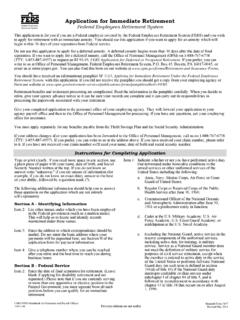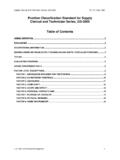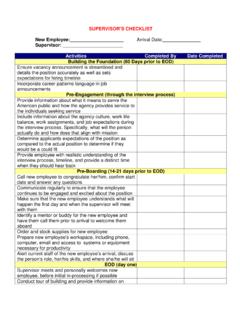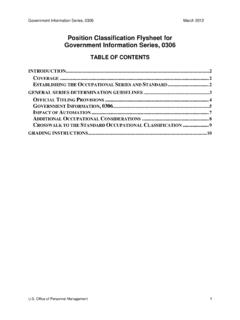Transcription of Introduction to the Federal Wage System Job Grading …
1 Federal wage System Job Grading System TS--44 Sep 1981, TS-13 Sep 1970, TS -1 Sep 1968 Introduction to the Federal wage System Job Grading System Table of Contents SECTION I -- 3 A. 3 1. 3 2. 3 3. 3 B. OUTLINE OF THE JOB Grading 4 1. Nature of the 4 2. Coverage of the 5 SECTION II -- ASSIGNING GRADES TO 5 A. KEY RANKING 5 1. Nature and purpose of key ranking 5 2. Listing of key ranking 5 3. Use of key ranking jobs in job 7 B. JOB Grading 7 1. Nature and purpose of 7 2. Content of 8 C. JOB Grading 9 1. Basic method for Grading nonsupervisory 9 2. Main points to 10 3. Mixed 11 4. Supervisor and leader 11 D. RELATIONSHIP BETWEEN JOB Grading STANDARDS AND DETERMINING 12 SECTION III -- CODES AND 12 A. THE CODING 13 1. Pay 2. Job family and 13 3. Grade 14 4. Method for indicating the 14 5. Using the coding 14 6. Establishing new 15 B.
2 15 1. Nonsupervisory 16 2. Leader and supervisor 16 3. Jobs in the 01 16 4. Mixed 17(continued) Office of Personnel Management 1 Federal wage System Job Grading System TS--44 Sep 1981, TS-13 Sep 1970, TS -1 Sep 1968 Table of Contents (continued) APPENDIX 1 -- SUMMARY OF JOB Grading APPENDIX 2 -- DESCRIPTIONS OF KEY RANKING Laundry Worker; Grade: Janitor (Light); Grade: Janitor (Heavy); Grade: Food Service Worker; Grade: Laborer (Light); Grade: Laborer (Heavy); Grade: Sale Store Worker; Grade: Fork Lift Operator; Grade: Warehouseman; Grade: Helper (Trades); Grade: Truck Driver (Light); Grade: Truck Driver (Medium); Grade: Packer; Grade: Stockroom Attendant; Grade: Sewing Machine Operator; Grade: Bindery Worker; Grade: Office Appliance Repairer; Grade: Truck Driver (Heavy); Grade: Truck Driver (Trailer); Grade: Cook; Grade: 27 Machine Tool Operator; Grade: Water Plant Operator; Grade: Painter.
3 Grade: Carpenter; Grade: Plumber; Grade: Motor Grader Operator; Grade: Automotive Mechanic; Grade: Aircraft Mechanic; Grade: Welder; Grade: Pipefitter; Grade: Sheetmetal Worker; Grade: Electrician; Grade: Machinist; Grade: Electronics Equipment Mechanic; Grade: Radar Mechanic (Ground); Grade: Tool, Die, and Gage Maker; Grade: Die Sinker; Grade: Modelmaker; Grade: Instrument Maker; Grade: APPENDIX 3 -- FACTOR Office of Personnel Management 2 Federal wage System Job Grading System TS--44 Sep 1981, TS-13 Sep 1970, TS -1 Sep 1968 SECTION I -- Introduction A. BACKGROUND 1. Authority On November 16, 1965, the President asked the heads of Federal departments and agencies to cooperate with the Chairman of the Civil Service Commission (now the Office of Personnel Management) in developing a coordinated wage System for Federal employees in trades and labor occupations.
4 On August 19, 1972, the Congress enacted Public Law 92-392 to provide an equitable System for fixing and adjusting the rates of pay for prevailing rate employees of the government and for other purposes. Thus, 92-392 is basically an extension and an update of the old Coordinated Federal wage System (CFWS). The new System contains nearly all the features of the CFWS but, among the changes, it adds coverage of the System to include non-appropriated fund and Veterans Administration Canteen Service employees in positions having trade, craft, or laboring experience and knowledge as the paramount requirement. 2. Objectives The policies and practices of the Federal wage System (FWS) are based on the principles that: a. wages shall be fixed and adjusted from time to time as nearly as is consistent with the public interest in accordance with prevailing rates; and b. there shall be equal pay for substantially equal work, and pay distinctions shall be maintained in keeping with work distinctions.
5 3. Action The law directs that common job standards, wage policies, and practices be developed to insure interagency equity in wage rates and to bring about equitable coordination of wage -fixing practices among the different executive departments and agencies. Thus jobs under the Federal wage System are to be graded on the basis of the same set of job standards and grade criteria, regardless of the department or agency involved or the community in which they are located. Office of Personnel Management 3 Federal wage System Job Grading System TS--44 Sep 1981, TS-13 Sep 1970, TS -1 Sep 1968 B. OUTLINE OF THE JOB Grading System 1. Nature of the System The job Grading System has been established in keeping with these directives. The System includes: a. a framework of key ranking jobs to serve as the basic pegpoints of the grade structure; b. job Grading standards to provide the criteria for determining the relative worth of jobs in terms of grades; c.
6 A job Grading method to assure consistency in the application of job standards; and d. a plan for coding and titling trades and labor jobs. The key ranking jobs establish the basic scale for Grading jobs. In turn, the job Grading standards define grade levels in keeping with that basic scale. The standards are the immediate "yardsticks" or tools used for deciding the grade levels of the jobs to which the standards apply. Under the job Grading method used, the grade of a job is decided by comparison of the whole job with grade definitions in an appropriate job Grading standard, considering job facts as indicated by the four factors of skill and knowledge, responsibility, physical effort, and working conditions involved in the work. The grade definitions in job Grading standards also are described in terms of these four factors. The method provides a means for analyzing and comparing jobs with applicable job Grading standards so that jobs involving the same level of work can consistently be assigned the same grade.
7 When directly applicable job Grading standards are not available, jobs can be graded consistently by comparison with grade-level definitions in standards for most nearly related occupations. Under this common job Grading System , jobs with sufficiently similar levels of work are placed in the same grade; jobs with significantly different levels of work are placed in different grades depending on the extent of the differences. The job Grading System is summarized graphically in APPENDIX 1. The identification of the significant similarities and differences in the levels of jobs by means of grades permits the setting of pay in keeping with work distinctions for jobs in many different occupations throughout the Federal Government. Office of Personnel Management 4 Federal wage System Job Grading System TS--44 Sep 1981, TS-13 Sep 1970, TS -1 Sep 1968 2. Coverage of the System The common job Grading System covers jobs in the executive agencies as indicated in the Operating Manual for the Federal wage System .
8 In effect, it applies to most trades and labor jobs outside the postal field service that are paid from appropriated and nonappropriated funds. The basic guidelines for determining trades or labor jobs, and for distinguishing them from General Schedule (GS) jobs, are in Section IV of the Introduction to the Position Classification Standards, published by the Office of Personnel Management. Other guidance is contained in individual FWS job Grading standards and General Schedule position classification standards. (Note: The instructions on Grading , coding, and titling trades and labor jobs contained herein apply only to jobs under the Federal wage System . This includes jobs converted from individual agency systems, following procedures in the Operating Manual for the Federal wage Systems and to new jobs established under the Federal wage System .) SECTION II -- ASSIGNING GRADES TO JOBS A. KEY RANKING JOBS 1.
9 Nature and purpose of key ranking jobs The nonsupervisory structure of the job Grading System has 15 grades. To establish a framework for that structure, the Office of Personnel Management determined the ranking relationships among certain key jobs. The descriptions of these key jobs, which are called key ranking jobs, serve as grade-level "pegpoints" for the 15-grade nonsupervisory structure. They reflect the relative worth of different key lines of work and levels within lines of work and control the alinement of the grade levels in all nonsupervisory job Grading standards. The ranking framework is based on the extensive network of relationships among the various kinds of jobs as well as the various grade levels within these kinds of jobs. In keeping with the factor guided job Grading technique, these relationships are highlighted in the descriptions of the key ranking jobs by means of the similarities and differences cited among the factors of skill and knowledge, responsibility, physical effort, and working conditions.
10 The Grading criteria in all job Grading standards are consistent with these relationships. 2. Listing of key ranking jobs The 39 key ranking jobs listed below and described in APPENDIX 2 are found in the majority of agencies which have trades and labor jobs. They represent a cross section of varying kinds of work as well as various skill levels within these kinds of work. (Note: The following titles are used only to identify the key ranking jobs. They should not be used as the guide for titling jobs. Rather, the official titles of jobs should be determined following the titling instructions in Section III, Codes and Titles.) Office of Personnel Management 5 Federal wage System Job Grading System TS--44 Sep 1981, TS-13 Sep 1970, TS -1 Sep 1968 Key ranking job title Grade 1. Laundry Worker 1 2. Janitor (Light) 1 3. Janitor (Heavy) 2 4. Food Service Worker 2 5. Laborer (Light) 2 6.










